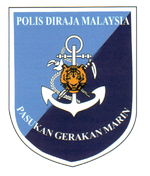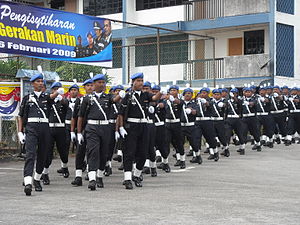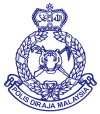- Marine Operations Force
-
Marine Operations Force 
Marine Operations Force InsigniaActive 1 September 1947 - Marine Police Force
6 February 2009 - Marine Operations Force (Present)Country  British Malaya (1947 - 1963)
British Malaya (1947 - 1963)
 Malaysia (1963 - present)
Malaysia (1963 - present)Branch  Royal Malaysia Police
Royal Malaysia PoliceType Water police Role Maritime Safety and Law Enforcement Size Classified Part of Directly under control of the Internal Security Department and Public Order Garrison/HQ Bukit Aman Police Headquarter, Kuala Lumpur Color of Beret Light blue beret Anniversaries March 25 (Police Days Anniversaries),
August 31 (Independence Day Anniversaries)Engagements - Malayan Emergency
- Indonesia–Malaysia confrontation
- Communist Insurgency War
- Operation MV Paulijing
Commanders Commander Senior Assistant Commissioner Isa Bin Munir The Marine Operations Force (Abbreviation: MOF; Malay: Pasukan Gerakan Marin; PGM) is the Marine Police division of the Royal Malaysia Police tasked with maintaining law and order and coordinating search and rescue operations in the Malaysian Maritime Zone and on the high seas. The Marine Police serves under the control of the Malaysian Internal Security Department and Public Order with the role of safeguarding the security of Malaysian waters from any threats.
Contents
Functions
Following the Inspector General of Police Order B112, the functions of Marine Operations Force are;
- To guard Malaysian waters.
- To maintain peace and uphold maritime laws
- To protect life and property at sea.
- To conduct ambush and carry out operations along Malaysian waters.
- To patrol, investigate and guard the coastal areas and islands of Malaysian waters.
- To provide facilities for communication in areas accessible only by sea or river.
- To defend the country against subversive elements and external threats.
History
The Marine Police used to be known as the Malay Water Police and its responsibility was to maintain security in Penang and the Straits of Johor. Owing to the increase in marine activities, the marine police was formed on September 1, 1947 in Batu Uban, Penang before being transferred to Gelugor, Penang with 19 boats contributed by the Customs Development and the Royal Malaysian Navy Reserve with 90 personnels.
During the Malayan Emergency, three members of the marine police perished in the battle of Bukit Kepong while fighting against the Communists.
During the Indonesia–Malaysia confrontation, the marine police also played a role in the crisis. The marine police co-operated with the navy in patrolling the coastal and riverine areas of the Malaysian Peninsula. Indonesian Irregular forces tried to infiltrate into Malaysia over water, especially using fishing boats and trawlers but many were successfully captured by the navy and the marine police. Some of the Indonesian Irregulars were shot dead when trying to escape from the Malaysian security forces, as well as having their weapons and equipments captured.
With the rapid development of Malaysia, the Marine Police expanded in terms of logistics and men. The expansion was notable during the 1960s, with a marked increase of 40 wooden PX class patrol boats and the addition of personnel. Subsequently, the duties of the Marine Police also expanded.
In 6 February 2009, the name of Malaysian Marine Police was changed to Pasukan Gerakan Marin (English: Marine Operations Force) with the aim of making the force more sensitive, progressive and innovative in their service to the community. The renaming was launched by the Minister of Home Affairs, Dato' Seri Syed Hamid Albar at PULAMAR (Abbreviation of Pusat Latihan Marin or Marine Police Training Centre), Tampoi, Johor Bahru and witnessed by Tan Sri Musa Hassan, the Inspector General of Police, the Director of Internal Security and Public Order, Dato' Hussin Ismail and all senior police officers and Malaysian media. In addition to functioning as regular police stations and huts, the Marine Police also took over police shacks located on islands, lakes, coastal and river areas. On November 24, 2008, a total of 41 marine police bases in the country were upgraded to Beach Police Stations and Beach Police Shacks.[1]
Incidents and accidents
Main article: List of Royal Malaysian police officers killed in the line of duty- On February 23, 1950, the Malayan communist guerillas launched an assault on the wooded police station at Bukit Kepong, Muar, Johore. As the result, 14 officers including three Marine Policemen were killed in that assault, known as MPC 60 Ibrahim Bin Adam, MPC 68 Awang Bin Ali and MPC 181 Basiron Bin Adam, while one Marine Policemen named MPC 37 Abu Bakar Bin Daud was wounded in action. The Communists also blew up the marine patrol boat at Bukit Kepong jetty near the Muar river to prevent reinforcement of the police station.
- At June 28, 2006, one officer of the marine police, MPC 144598 Mohd Juriya Bin Awang went missing when a patrol boat from Pasir Panjang Marine Police Station capsized and sank in heavy shore about two nautical miles (4 km) off Pasir Panjang on routine duties, Sekinchan while Cpl Ahmad Zubairi Shahudin and MPC Mohd Khairi Seman, two of the crews in the boat, managed to swim ashore. An intensive search and rescue effort was launched by the police, Fire and Rescue Services Department, Malaysian Marine Department and local villagers to locate the missing officer.[2] Three weeks later after the incident, the body of the officer was later found at 7.5 nautical miles (13.9 km) off Pulau Payar, near the Kuala Kedah river.[3]
Organization
 The marine police march during the declaration of PGM in 6 February 2009. The officers are wearing skyblue berets, the new berets of the unit and carried the M16 rifle.
The marine police march during the declaration of PGM in 6 February 2009. The officers are wearing skyblue berets, the new berets of the unit and carried the M16 rifle.
The Marine Operations Force is currently headed by Senior Assistant Commissioner II Dato' Isa bin Munir. It operates from five regional bases around the peninsula and East Malaysia. It also has a police base at Putrajaya for the security of the lake. Each of these regional bases are organised similarly to the Neighbourhood Police Centres of the land divisions, and conduct patrols within its respective maritime sectors.
The Marine Police is organised into five main bases:
- Northern Region Marine Police (Region 1)
- Based at Batu Uban, Penang. Has responsibility for the maritime activities in the states of Perlis, Penang, Kedah, Perak and Selangor
- South Region Marine Police Force (Region 2)
- Based at Tampoi, Johor Bahru, Johore. Has responsibility for the maritime activities in the states of Negeri Sembilan, Malacca and Johore
- East Region Marine Police Force (Region 3)
- Based at Kemaman, Terengganu. Has responsibility for the maritime activities in the states of Kelantan, Terengganu and Pahang
- Sabah Region Marine Police Force (Region 4)
- Based at Sandakan, Sabah. Has responsibility for the maritime activities in the state of Sabah and Labuan
- Sarawak Region Marine Police Force (Region 5)
- Based at Kuching, Sarawak. Has responsibility for the maritime activities in the states of Sarawak
Roles
This team is responsible in patrolling Malaysian Territorial Waters (MTW), Exclusive Economic Zone (EEZ) and Contiguous Zone. Headed by Marine Police Commander centered at Major Police Headquarters at Bukit Aman, Kuala Lumpur and fully responsible to Inspector-General of Police through to Director of Internal Security Department and Public Order in every aspects of administration and operations.
The major duties are:-
- Search and rescue in the territorial waters of Malaysia and EEZ. Especially aiding in transporting flood victims or natural disasters, especially shipwreck etc.
- Assisting other units in the police organisation perform duties other than marine police tasks with the approval from the Director of Internal Security Department and Public Order with the Marine Police Commander advice.
- Perform diving duties whenever required by the police force.
- Harbour from the threats from the sea.
- Conduct joint training with a neighbouring country in Coast Rendezvous, patrol coordination, search and rescue operations.
Operations
The PGM conducts round-the-clock patrols in MTW from its five regional bases, in an area of more than 142, 393 km² and 450, 233 km² for EEZ as well as 4490 km for coastline. It is also responsible for maintaining law and order on most of Malaysia's islands.
While piracy was the main source of concern leading to the establishment of the Marine Police, it has become almost a non-issue today with no cases of piracy in Malaysian Territorial Waters in the last decade. Crimes in the offshore islands or in the waters are also markedly low.
Ops MV Paulijing
August 22, 2005: A hijacked ship belonging to a Hong Kong citizen has entered the Straits of Malacca, after investigation, the ship was actually reported missing in 2003 in the waters Batam, Indonesia. At first, the ship will be detected by the Marine Operations Force. Marine Operations Force received information at about 9.00 am yesterday that the ship MV Natris trusted and has changed its name to MV Paulijing enter the Straits of Malacca and was on his way from Khandra, India to Port of Ho Chi Minh City, Vietnam. Responding on information, the Marine Operations Force have sent four marine police patrol vessels which were approaching the ship at about 10 am yesterday, ordered the captain of the ship was to stop. However, the captain of the MV Paulijing refused to heed to the order and continued to head south.
At the same time, five officers and 32 members of 69 Commando counter-terrorist operators was flown to Kukup, Pontian, Johore at about 5 pm yesterday. From Sultan Ismail Airport, Senai, the unit brought by helicopter and they were briefed by the Deputy Superintendent of Police Mohd Yazib Bin Abd Aziz. At 11 pm, Marine Operations Force and 69 Commando to Pulau Pisang and ready to respond at the appropriate time until at about 3:20 am of 69 Commandos and the Marine SWAT unit managed to board and capture the ship.
After inspection of the ship is carrying soybeans and a substance believed to vinegar. The ship was also carrying 19 crew and a captain of the Chinese citizens who are between the ages of 20 to 45 years. The ship was then taken to the waters off Tanjung Piai for further examination and report. This operation has been reported in the 999 program on TV3 in 2005 ago.[4][5]
Maritime border control
Over the period 2005 to November 2008, PGM was successful in 12,054 cases of busts and summons above various type of offence in beach coastal and national waters.
- Statistic of Arrested and Summons from 2005 to November 2008
Fiscal Year 2005 2006 2007 2008 Fisheries Act 230 325 236 385 Custom Act 226 289 236 387 Immigration Act 276 430 544 624 Dangerous Drug Act 139 124 87 101 Merchant Shipping Ordinance 905 878 1, 048 1, 197 Police Act 60 57 71 76 Paddy and Rice Act 351 703 177 188 Controlled Substance Act 84 72 96 269 Offence others 352 365 343 520 Total 2, 623 2, 843 2, 841 3, 747 Entirety Total 12, 054 Firearms and equipment
All officers and men of the PGM are equipped with the Smith & Wesson Model 15 .38 Special service revolver, similar to their counterparts in land divisions, as their primary side weapon. The Beretta 92, Browning Hi-Power Mk.3, Glock 19, Heckler & Koch USP and Walther P99 service pistol is also issued to PGM officers and UNGERIN squad. Other firearms such as the Heckler & Koch MP5, the M16 rifle are also stowed aboard each patrol craft, with the M4 carbine and Remington 870 pump action shotgun as an additional weapon for the UNGERIN. Mounted on the boats themselves, are weapons such as the 7.62mm FN MAG General Purpose Machine Gun, and the 12.7mm M2 Browning machine gun, depending on the type of craft.
Current fleet
Currently, the PGM utilised the 15 PZ class patrol boats, 33 PX class, 68 PA/PT/PC/PLC and 4 PSC/PGR/PAR class patrol boats. From two current base during established, currently the branch have 5 the main base, 11 small base and 24 forward base.
Offshore Patrol Craft (PX Class)
Ships - PX 6
- PX 8
- PX 9
- PX 11
- PX 12
- PX 17
- PX 19
- PX 20
- PX 21
- PX 24
- PX 28
- PX 29
- PX 30
- PX 31
- PX 32
- PX 33
Origin  Malaysia
MalaysiaLength 29 metres Beam 6 metres Draft 1.7 metre Speed 17 knots (30 km/h) Weapons 2x M2 Browning machine gun Small Arms M16 rifles, HK MP5, shotguns and Pistols/Revolvers Note: Ordered in 1979 from Penang Shipbuilding Company. First delivery in June 1981, last pair completed in June 1982. Brooke Marine provided lead yard services.
Inshore Patrol Craft (PA Class)
Ships - Camar Laut 6 (PA 20)
- Camar Laut 22 (PA 22)
- Camar Laut 24 (PA 24)
- Camar Laut 25 (PA 25)
- Camar Laut 31 (PA 31)
- Camar Laut 41 (PA 41)
- Camar Laut 43 (PA 43)
- Camar Laut 47 (PA 47)
- Camar Laut 49 (PA 49)
Origin  Germany/
Germany/ Malaysia
MalaysiaLength 14.8 metres Beam 2.7 metres Draft 0.8 metre Speed 30 knots (60 km/h) Weapons 2x 12.7mm M2 Browning machine gun
20mm Oerlikon cannonSmall Arms M16 rifle and pistols New Police Strike Craft Vessels (PSC Class)
On July 11, 2007, the PGM purchased 10 units of Marine Alutech Watercat M14 PSC class landing craft vessels from Marine Alutech OY AB Service with 22 passengers capacity and able 30+ knots high speeds, possibly equipped with 12.7mm NSV machine gun, 40mm grenade machine gun and 120m Patria NEMO mortar to used by marine police as well as UNGERIN operatives for amphibious assault duties even in shallow waters. The boats are built by Geliga Slipway Sdn Bhd in Malaysia. The boats are to be supplied in 2008-2009.[6][7]
Ships - Tebuan Laut 35 (PSC 35)
- Tebuan Laut 17 (PSC 17)
- -
- -
(6 more on delivery)
Origin  Finland
FinlandLength 15.4 metres Beam 4 metres Draft 0.8 metre Speed 45 knots (80 km/h) Weapons 2x General Purpose Machine Guns Special force
A special operations squad of marine police was established to counter various terrorism threats. Known as UNGERIN, they received special training by the United States where they were trained in the specific doctrines to increase the security of Malaysian waters. The UNGERIN were provided with US special firearms, similar to those used by US counter-terrorist units.
References
- ^ "Polis Marin kini Pasukan Gerakan Marin" (in Bahasa Malaysia). Utusan Malaysia. 2009-02-07. http://www.utusan.com.my/utusan/info.asp?y=2009&dt=0207&pub=utusan_malaysia&sec=Dalam_Negeri&pg=dn_16.htm&arc=hive. Retrieved 2009-03-04.
- ^ "Crew Member Goes Missing After Marine Patrol Boat Sinks". Bernama. 2006-06-28 18:37. http://www.bernama.com/maritime/printable.php?id=205648. Retrieved 2009-08-07.
- ^ "Policemen drown in Selangor, his body found later at Kedah". Utusan Malaysia. 2007-04-06. http://www.utusan.com.my/utusan/info.asp?y=2006&dt=0724&pub=utusan_malaysia&sec=Dalam_Negeri&pg=dn_02.htm&arc=hive. Retrieved 2009-08-07.(Malay)
- ^ "Marine Police Detain Ship Believed Hijacked Three Years Ago". bernama.com.my (Bernama). August 23, 2005. http://maritime.bernama.com/news.php?id=151755&lang=en. Retrieved 2011-09-05.
- ^ "Malaysia seizes `stolen' ship in nighttime raid". taipeitimes.com (Taipei Times). August 25, 2005. http://www.taipeitimes.com/News/world/archives/2005/08/25/2003269078. Retrieved 2011-09-05.
- ^ "Saksan asevoimat harkitsee venehankintaa Suomesta" (in Finnish). Ruotuväki article. 2007-07-15. http://www.mil.fi/ruotuvaki/index.dsp?aid=3227. Retrieved 2008-06-02.
- ^ "Marine Alutech delivers 10 PSC landing crafts for Royal Malaysian Police". Marine Alutech websites. 2007-07-11. http://www.marinealutech.com/news.htm. Retrieved 2008-11-27.
See also
Royal Malaysian Police History 
Law Departments Royal Malaysian Police Museum • Police Resource Department • BAKA • Police Logistic Department • Criminal Investigation • Internal and Public Security • Special Branch • K-9 Unit • Police Administrative and Civilian Staff Union • Police Volunteer Reserve • Auxiliary Police • National Police Cadet • Cooperative Society • PULAPOL • Muar Police Training Centre • Kuala Lumpur Police College • Student's Police Volunteer Reserve Corps • Tourist PoliceArmed units General Operations Force • Senoi Praaq • Unit Tindakan Cepat • Counter Smuggling Unit • Federal Reserve Unit • Police Mounted Units • Marine Police • Police Air Wing • Traffic Police Branch • Pasukan Gerakan Khas • UNGERINCampaigns Other topics Bukit Kepong • Gerak Khas • RELA Corps • Memali Incident • Bukit Kepong Incident • Al-Ma'unah • Squatgate • Police officers killed in the line of dutyCategories:- Government agencies established in 1947
- Royal Malaysian Police
- Maritime safety
Wikimedia Foundation. 2010.


